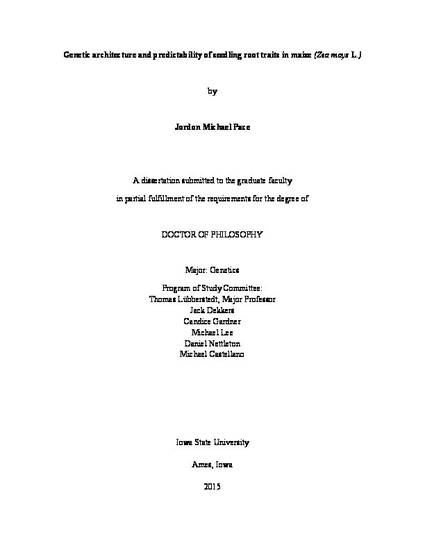
- Agriculture and
- Genetics
The maize (Zea mays L.) root system is important for proper growth and productivity of the plant. There is substantial genetic and phenotypic variation for root architecture, which gives opportunity for selection. Root traits, however, have not been used as selection criterion mainly due to the difficulty in measuring, as well as their quantitative mode of inheritance. Studying seedling roots offer an opportunity to study multiple individuals and to enable repeated measurements per year as compared to adult root phenotyping. Here we have evaluated phenotypic and genotypic variation within seedling root traits for two panels of inbred lines. Constructed maize association mapping panels were used within both a candidate gene based and genome-wide based association study to connect putative QTL with seedling root traits. Also, to collect seedling root phenotypes a software program ARIA (Automatic Root Image Analysis) was developed in order to allow for larger scale quantitative studies. A Genome-wide association mapping panel was also used as a training population to predict the performance in relation to total root length at the seedling stage of a large set of maize inbred lines. Candidate gene association analyses revealed several polymorphisms within the Rtcl, Rth3, Rum1, and Rul1 genes associated with seedling root traits. Several nucleotide polymorphisms in Rtcl, Rth3, Rum1, and Rul1 were significantly (P<0.05) associated with seedling root traits in maize suggesting that all four tested genes are involved in the maize root development. We developed a new software framework to capture various traits from a single image of seedling roots based on the mathematical notion of converting images of roots into an equivalent graph. This allows automated querying of multiple traits simply as graph operations. This framework is furthermore extendable to 3D tomography image data. Within a Genome-wide association analysis utilizing both a general linear model and mixed linear model, a GWAS study was conducted identifying 268 marker trait associations (p ≤ 5.3x10-7). Analysis of significant SNP markers for multiple traits showed that several were located within gene models with some SNP markers localized within regions with previously identified root quantitative trait loci. Gene model GRMZM2G153722 located on chromosome 4 contained nine significant markers. This predicted gene is expressed in roots and shoots. Finally a Genomic prediction study successfully predicted extreme groups with regard to TRL were significantly different (p=0.0001). The difference of predicted means for TRL between groups was 145.1 cm, and 118.7 cm for observed means, which were significantly different (p=0.001). The accuracy of predicting the rank 1-200 of the validation population based on TRL, longest to shortest was determined using a Spearman correlation to be ρ=0.55. In conclusion this work exemplifies the vast amount of diversity seen within root architecture even at the seedling stage and lays ground work for future studies two build upon moving forward studying roots.
Available at: http://works.bepress.com/michael-pace/10/
